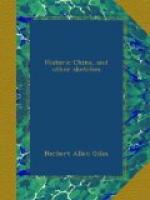This festival dates from the time of the Han dynasty, or, in round numbers, about two thousand years ago. Originally it was a ceremonial worship in the temple of the First Cause, and lasted from the 13th to the 16th of the first moon, bringing to a close on the latter date all the rejoicings, feastings, and visitings consequent upon the New Year. In those early days it had no claim to its present title, for lanterns were not used; pious supplicants performed their various acts of prayer and sacrifice by the light of the full round moon alone. It was not till some eight hundred years later that art came to the assistance of nature, and the custom was introduced of illuminating the streets with many a festoon of those gaudy paper lanterns, without which now no nocturnal fete is thought complete. Another three hundred years passed away without change, and then two more days were added to the duration of the carnival, making it six days in all. For this it was necessary to obtain the Imperial sanction, and such was ultimately granted to a man named Ch’ien, in consideration of an equivalent which, as history hints, might be very readily expressed in taels. The whole thing now lasts from the 13th of the moon, the day on which it is customary to light up for the first time, to the 18th inclusive, when all the fun and jollity is over and the serious business of life begins anew. The 15th is the great time, work of every kind being as entirely suspended as it is with us on Christmas Day. At night the candles are lighted in the lanterns, and crackers are fired in every direction. The streets are thronged with gaping crowds, and cut-purses make small fortunes with little or no trouble. There being no policemen in a Chinese mob, and as the cry of “stop thief” would meet with no response from the bystanders, a thief has simply to look out for some simple victim, snatch perhaps his pipe from his hand, or his pouch from his girdle, and elbow his way off as fast as he can go.
Plenty of lights and plenty of joss-stick would be enough of themselves to make up a festival for Chinamen; in the present instance there should be an extra abundance of both, though for reasons not generally known to uneducated natives. Ask a coolie why he lights candles and burns joss-stick at the Feast of Lanterns, and he will probably be unable to reply. The idea is that the spirits of one’s ancestors choose this occasion to come back dulces revisere natos, and that in their honour the hearth should be somewhat more swept and garnished than usual. Therefore they consume bundle upon bundle of well-scented joss-stick, that the noses of the spirits may run no risk of being offended by mundane smells. Candles are lighted, that these disembodied beings may be able to see their way about; and their sense of the beautiful is consulted by a tasteful arrangement of the pretty lamps in which the dirty Chinese dips are concealed. Worship on this occasion is tolerably




